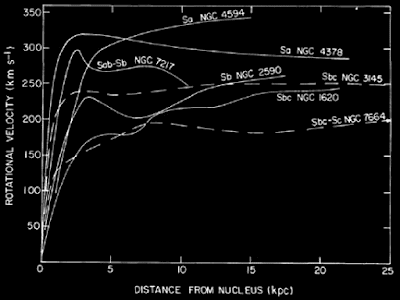I've made a mistake.
I have been describing galaxy rotation incorrectly for some time.
I retract the remark that galaxies are acting like rigid wheels. I would describe the motion of the stars at the outer edge of a spiral galaxy being faster than stars in the middle and faster still than the inside stars. Like spokes on a wheel.
That's wrong.
My apologies for confusion caused.
I misinterpreted information about galactic rotation.
In fact, as measured by Vera Rubins, the inner stars are moving slowly (say 50 km/s). The stars further out are moving faster (100 km/s). The stars further out are going faster still (maybe 200 to 300 km/s). And then the speed curve flattens. The stars in the middle and outer limits are going this same speed (200 to 300 km/s).
I was mistakenly continuing to ramp up the speed, the further we went out.
Given the stars in the outer spiral arms have a greater distance to travel and their speed is the same at ones in the middle, they fall behind!
This consequently explains something for me: the twisting or torquing effect. Which I could not resolve with the rigid disc approach.
All this revealed itself to me as Rhonda and I talked about types of objects in the galaxy, where they were located, how they contributed to the formation of the galaxy, and so on.
Wow.
Subscribe to:
Post Comments (Atom)



No comments:
Post a Comment